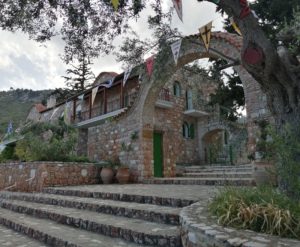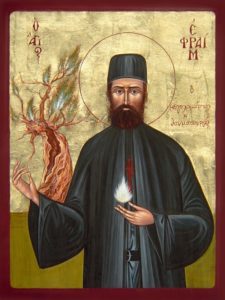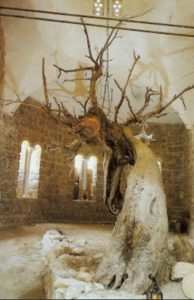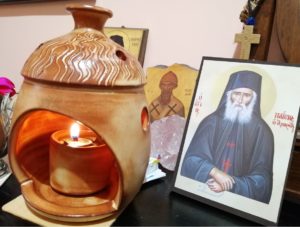St Efraim Monastery is world famous for the saint’s chilling tale and the miraculous healings connected to his name… Earlier this month, I had the chance to visit St Efraim’s monastery one quiet afternoon. It is located on a mountain overlooking the beautiful seaside town of Nea Makri in East Attica. I was lucky enough to find only a small crowd in the monastery. From what I’d heard, the norm is an endless trail of coachfuls coming and going all day.
St Efraim monastery is visited by Orthodox Christians throughout the year, many going to pay their respects and to pray for a healing for them or their loved ones. The saint is famous for the many visions that the faithful have had of him over time – and still do today. He has appeared in apparent human form even before unsuspecting people who had never heard of him. The saint gave these people advice for their health, and sometimes simply prompted them to get some oil from the lamps at the monastery to put on the part of the body that needed healing… And healings happened every time, apparently. The monastery still receives a multitude of healing testimonies from many parts of Greece and abroad.
Inside the monastery, cotton wool drenched in oil from the lamps are offered in individual tiny plastic bags to the visitors. Those hoping for a healing or just asking for protection are able to buy tall candles, as tall as a person, to light up and leave inside a chapel.
St Efraim’s body is in skeletal form and is kept in a beautiful open casket for people to pay their respects too.
If you’re interested to know more about the saint’s life, his terrible death at the hands of Turkish invaders, and the miraculous way in which his remains were found hundreds of years later, you’re welcome to find out everything in the next segment.
Either way, I hope you will enjoy the photographs I took around the monastery. It’s so peaceful a setting, high on a mountain top, edged by olive groves and overlooking the town of Nea Makri and the coast.
The monastery itself is decorated with beautiful stonework. The court is particularly quaint!
I am including some photos of the seafront at Nea Makri, too. It was the quietest I’ve ever seen it, but it makes sense as it was a weekday. Every weekend, and especially in the summer season, it’s always packed.
GO HERE TO SEE THE PHOTOS
Who is St Efraim?
St Efraim was born in Trikala on September 14 (Cross Day) in 1,384 A.D. He was one of 8 children and was given the name Constantinos. When his father died, Constantinos was still a small boy, and his mother took on all the challenges of raising her children on her own. Constantinos expressed a love for God and Christianity from a very young age.
When he was 14 years old, his mother feared the Turks would take him during another of their raids where they took young boys to raise them as Genitsari (Note: Genitsari was a brutal rank of ‘Turkish’ soldiers that hated Greeks with passion. All of them had been taken away when they were small boys (Greek Orthodox children) to be given a strict military upbringing while brainwashed to hate their own nation).
Heeding his mother’s advice, Constantinos left Trikala to seek another part of Greece that would be safe from Turkish raids. She had also advised him to find a monastery and become a monk since he had so much affinity for the monastic life. After many wanderings, Constantinos wound up on Mount Amomon (Mountain of the Clean), which is the very place where his monastery now stands.
Constantinos settled well in the monastery. When he turned 18, he was declared a monk and was given the name Efraim. After a few years, he became a priest. By then, he much preferred to live in natural caves on the mountain as opposed to the monastery.
In 1424, Turkish troops arrived on the mountain and raided the monastery looking for gold. They found next to nothing and slaughtered everyone they found. That day, Efraim was spared as he wasn’t in the monastery. When he returned the next day, he found everyone dead and buried them on his own, then went back to his cave. After that, he returned to the monastery only on special days to do mass in the church.
On such a day (Cross Day), September 14, 1425, the Turks returned and this time they caught him. What followed was 8 months of imprisonment and they tortured him from time to time, insisting to find out where the gold was, but there was none to give.
Finally, on May 5, 1526, the Turks hung St Efraim upside down from a mulberry tree in the courtyard of the monastery and killed him by stabbing him in the stomach with a lit torch.
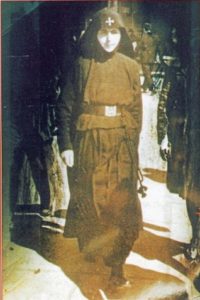 Fast forward 419 years later…
Fast forward 419 years later…
In 1945, a nun called Makaria, driven by divine inspiration, decided to go to Mount Amomon and settle in one of the old cells of the ruined old monastery. Soon, she began to clear the rubble of the old church inside it, hoping to make it operational again. She asked a local, whom she hired as a worker, to dig at a specific spot, as she had been receiving insistent advice in the form of an eerie whispering voice to do so.
The man was difficult and refused to dig in the specific spot, but the nun insisted so he finally gave up. Digging at about 1.70 meter deep, they found what looked like an old cell and the remains of a man. He wore the robe of a priest, and it was intact. A divine fragrance filled the air as soon as the skeleton came to light.
That same night, while she prayed, Makaria heard footsteps. They were coming from where she had found the remains. On her way there, at the entrance of the church, she saw a vision. It was a tall and thin man, with a long black beard that reached down to his neck. He had dark eyes, and he was wearing the robes of a monk. One hand emitted fire, while the other was positioned in a gesture of blessing. He spoke to her then, asking her to move his remains away from the crypt near the grave where she had placed them.
The next day, Makaria cleared the bones and placed them in a crypt inside the church. That night, St Efraim appeared in her dream to thank her. That was also when he gave her his name.
Over time, St Efraim disclosed to her all the details of what had happened with the Turks and how he had been murdered.
According to the Greek Orthodox Church, the miracles of St Efraim to this day are in the thousands. He is honoured twice a year. On May 5, where his assassination is commemorated, and on January 3, the anniversary of the discovery of His remains.
The mulberry tree where Efraim gave up his spirit has been preserved over the centuries, or, rather, what is left of its dried up frame. Kept safe in an enclosed space in the monastery, it stands as a silent witness to St Efraim’s brutal and untimely death.
Interested in Greek saints and their miracles? Check out my posts about St Spyridon (patron saint of Corfu), St Vasileios (the Greek ‘Santa Claus’!) and St George.
Greek vigil lamps, frankincense, and how to clean up your house from stale energy https://effrosyniwrites.com/2022/05/13/greek-vigil-lamps-frankincense/
YOU KNOW WHAT THEY SAY… SHARING IS CARING! Tweet this to spread some love:
St Efraim of Nea Makri. A Greek saint's chilling tale #Greek #Greece #saints Share on X
3 FREE books for you! Sign up below to receive them instantly!
NEW! Clean Christmas romance. Single mother Cathy Roussos gave up on love long ago, and veterinarian Alex Rallis doesn’t believe in it, but one magical Christmas on a Santorini farm might just change everything…
Check it out on Amazon Read a FREE sample!
A clean romantic suspense short read with an unreliable narrator that’ll keep you guessing! Vera is losing her mind over famous actor Yannnis Ksenos, except, she isn’t just a fan… Now, she plucks up the courage to ring his doorbell… Visit Amazon

